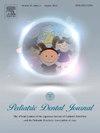不成熟恒牙撕脱的再生牙髓治疗:范围综述
IF 0.8
Q4 DENTISTRY, ORAL SURGERY & MEDICINE
引用次数: 0
摘要
目的评价再生牙髓治疗(RET)对未成熟恒牙撕脱的治疗效果,这是牙外伤治疗的一个重大挑战。本综述旨在评估RET治疗未成熟恒牙撕脱的结果、方案、并发症和有效性,确定研究空白以推进临床应用。材料和方法本综述包括PubMed、Cochrane Central Register of Controlled Trials、Web of Science、Scopus和Science Direct的综合检索,时间跨度超过20年,辅以滚雪球式检索。任何语言的全文文章,只要是随机/非随机临床试验或前瞻性/回顾性队列研究,随访至少12个月,符合PCC框架。采用标准化表格提取数据,包括作者、出版年份、研究来源、目的、样本量、干预方案、随访、结果测量和测量方法。结果在1623份文献中,14项研究符合纳入标准。这些研究涉及82颗被撕脱的未成熟前牙,在至少12个月的随访中,总体成功率为44%(36/82),成功的定义是根尖周放射性分辨率的分辨率和积极的牙根发育。纳入的研究显示RET方案存在显著差异,以氢氧化钙作为主要的管内药物,血凝块作为主要支架,17%(乙二胺四乙酸)EDTA加生理盐水作为最常见的冲洗方法。值得注意的是,肺泡外时间和储存条件显著影响结果,使用生理介质在60分钟内再植效果最佳。结论:虽然RET治疗未成熟撕脱牙的成功率约为44%,但目前研究中治疗方案的可变性和有限的样本量表明,需要进行更广泛的研究和标准化的方案,以验证牙科医生的使用。本文章由计算机程序翻译,如有差异,请以英文原文为准。
Regenerative endodontic treatment in avulsed immature permanent teeth: A scoping review
Aim
This scoping review assessed the performance of regenerative endodontic treatment (RET) in avulsed immature permanent teeth, which presented a significant challenge in dental trauma management. This scoping review aims to evaluate RET outcomes, protocols, complications, and effectiveness in avulsed immature permanent teeth, identifying research gaps to advance clinical application.
Materials and methods
The review encompassed a comprehensive search of PubMed, Cochrane Central Register of Controlled Trials, Web of Science, Scopus, and Science Direct, spanning over 20 years, supplemented by snowball searching. Full-text articles in any language were eligible if they were randomized/non-randomized clinical trials or prospective/retrospective cohort studies with at least 12 months of follow-up, following the PCC framework. Data were extracted using standardized forms, including author(s), publication year, study origin, aim, sample size, intervention protocol, follow-up, outcome measures, and measurement methods.
Results
Of the 1623 records reviewed, 14 studies met the inclusion criteria. These studies, involving 82 avulsed immature anterior teeth, demonstrated an overall success rate of 44 % (36/82) over a minimum 12-month follow-up, with success defined by periapical radiolucency resolution and positive root development. The included studies showed significant variability in RET protocols, with calcium hydroxide as the primary intracanal medicament, blood clot as the main scaffold, and 17 % (Ethylenediaminetetraacetic acid) EDTA with saline as the most common irrigation method. Notably, extra-alveolar time and storage conditions significantly influenced outcomes, with replantation within 60 min using a physiological medium yielding the best results.
Conclusion
While RET demonstrates approximately 44 % success in treating avulsed immature teeth, the variability in treatment protocols and the limited sample sizes in current studies highlight the need for more extensive research and standardized protocols to validate its use by dental practitioners.
求助全文
通过发布文献求助,成功后即可免费获取论文全文。
去求助
来源期刊

Pediatric Dental Journal
DENTISTRY, ORAL SURGERY & MEDICINE-
CiteScore
1.40
自引率
0.00%
发文量
24
审稿时长
26 days
 求助内容:
求助内容: 应助结果提醒方式:
应助结果提醒方式:


